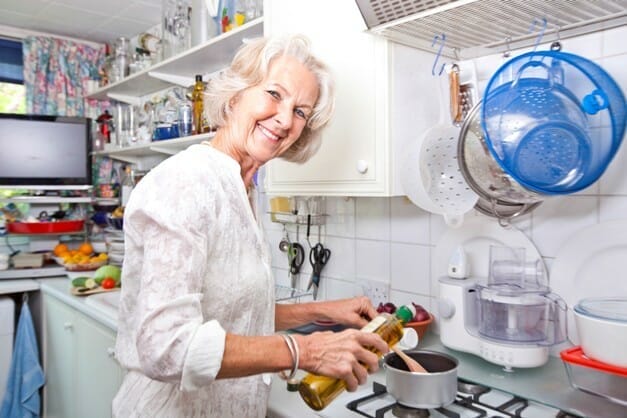Sodium chloride.
In more simple terms, table salt. It’s a staple part of any home’s kitchen. It doubles as a preservative and seasoning for dishes, drawing out and enhancing the flavor of food.
But when you’ve got chronic kidney disease, salt on your food is like, well... salt on your wounds.
The Problem with Sodium
Sodium (chemical symbol: Na) is a necessary element for the body’s development. This mineral is used by the kidneys in regulating the balance of fluids inside the body.

However, your damaged kidneys are not as efficient as they were before. Every time you take in high-sodium foods, the kidneys fail to filter out the excess in your body.
The gradual build-up of this nutrient can also cause fluid to accumulate in the body, increasing blood pressure and causing swelling of the extremities (feet and hands), among others.
Now, you might think, “I’ll just stay away from salty food, then.” That is a good first step, but what you may not realize is, sodium is present in virtually all food. So you might be eating high amounts of sodium without knowing it, because the food isn’t salty at all!
This is why kidney disease patients are advised to go on a renal diet, because this kind of diet limits some nutrients that could damage your kidneys further, particularly sodium.
High-Sodium Foods to Avoid
Numero uno in this list of foods to avoid are processed or cured foods. These food items use massive amounts of sodium for preservation and longer shelf life, so it’s best to stay away from some of these, like:
Even bacon, usually one of the most common breakfast food items especially in America, has a whopping 137 mg of sodium in a single 8-gram strip. That’s about 1,717 mg per 100-gram serving!
Some other high-sodium foods to avoid are listed below:
- Sausage
- Corned beef
- Spam
- Salted crackers
- Corn chips
- Pretzels (salted)
- Buttermilk
- Cheese
- Canned soups
- Tomato products
How to Limit Your Sodium Intake
The recommended sodium intake limit for kidney disease patients is 1,500 mg of sodium per day.
One habit that you could start on your renal diet is to check the nutrition labels of foods you buy. Most food items from supermarkets and stores indicate the amount of sodium per serving in their containers. If you can, find ones with salt-free, less sodium, unsalted and the like on the labels.
Another thing to consider: be careful about salt substitutes. Potassium chloride is the most common choice but, surprise; excessive potassium can also aggravate your kidney disease.
An additional step to take, and this is an extremely helpful one, is to switch up your recipes. Instead of using salt to season your dishes, use herbs and spices. They’ll help you lessen the sodium in your diet and add more flavor to your meals.

Here are some spices you can use for your dishes and the ingredients they pair best with:
Spice | Goes best with |
|---|---|
allspice | beef, eggs, fish, fruits, vegetables, beverages, baked products, desserts |
basil | lamb, fish, eggs, vegetables, sauces |
bay leaf | beef, chicken, veal, fish |
cinnamon | chicken, pork, fruits, baked products, beverages, vegetables |
cloves | beef, pork, fruits |
curry (salt-free) | beef, chicken, lamb, veal, eggs |
dill | chicken, veal, fish, vegetables |
ginger | chicken, pork, fruits, vegetables, baked products, beverages |
majoram | eggs, fish, meats, poultry |
mustard powder | meats, poultry, fish, eggs, vegetables |
parsley | beef, chicken, fish, salads, sauces |
rosemary | beef, lamb, chicken, turkey |
sage | meats, fish, stuffing, vegetables |
savory | egg dishes, meats, poultry, stuffing, rice, vegetables |
tarragon | chicken, fish, meats, egg dishes, sauces, vegetables |
thyme | fish, meats, poultry, eggs, stuffing, vegetables |
Bit of an advice: the best way to apply leaf-type herbs is to crush or rub them into the ingredients to release full flavor.
Keep in mind that these spices and herbs shouldn't overpower your food's taste, but since you're not using salt, you will need to find the right amount of spice for your dish.
Regulating your sodium is one of the best ways to slow down the worsening of your kidneys and delay dialysis indefinitely. And you don't need to, as they say, take it with a grain of salt.
However, don't forget to always consult with professionals for specifics regarding your health. Your nephrologist and renal dietitian will know what's best for your condition. So, if they have advice that goes against this article, their opinion takes priority.
Sodium and Your CKD Diet: How to Spice Up Your Cooking - National Kidney Foundation:
https://www.kidney.org/atoz/content/sodiumckd
Salt Substitutes - Cleveland Clinic:
https://my.clevelandclinic.org/health/articles/17452-salt-substitutes

